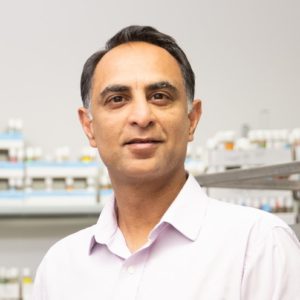by Buck Institute
January 21, 2020 . News
More details on 500% lifespan extension highlight Buck’s role in moving science forward
An amazing study with Buck co-authors reporting a nearly 500% increase in lifespan of the nematode C. elegans got a lot of buzz around the web earlier this month. In humans, this is the equivalent of living 400-500 years! This is rightfully big news. Buck professor Pankaj Kapahi remembers fielding reporter calls the first time his lab made this discovery and published in Cell Reports —back in 2013!
In that study, Di Chen, a postdoc in the Kapahi lab, created a worm with mutations in two different cellular pathways known to influence aging and lifespan. One mutation, in the daf-2 gene, is part of the insulin signaling pathway and extends lifespan by 100% in C. elegans. Another mutation, related to the TOR (Target of Rapamycin) pathway that regulates cellular growth and proliferation, typically extends lifespan by 30%. If you’re doing the math in your head, you might expect these two mutations to add up to 130% extension when combined. However, there is a synergistic effect and lifespan in these mutants increases 454%! This is particularly exciting because these pathways are shared with mammals, so this work has potential relevance for human biology.
 Insulin signaling and TOR are among the most interrogated pathways in aging research, but combining mutations to get these stunning results is not straightforward; there are multiple ways to mutate these genes, and each tweaks lifespan differently. Says Kapahi, “All credit to Di [Chen]. You’d be shocked to look at all the lifespan experiments he did. It’s a really colossal amount of work and it’s a reward for all the hard work he did.”
Insulin signaling and TOR are among the most interrogated pathways in aging research, but combining mutations to get these stunning results is not straightforward; there are multiple ways to mutate these genes, and each tweaks lifespan differently. Says Kapahi, “All credit to Di [Chen]. You’d be shocked to look at all the lifespan experiments he did. It’s a really colossal amount of work and it’s a reward for all the hard work he did.”
Nearly 500% lifespan extension was big news back in 2013, too. Kapahi remembers Jay Leno joking about it on the Tonight Show, and Francis Collins, the director of the NIH, covered it in his blog.
So why is this news now? It’s because we’re finding out how this double mutant gets this amazing lifespan extension, and it gives us new clues into how signals throughout the body coordinate to determine lifespan. And the growth of this project all stems from collaborations started at the Buck. Di Chen, the former Kapahi postdoc, is now an Associate Professor at Nanjing University in China. He, along with Aric Rogers, another former Kapahi postdoc and now an Assistant Professor at the MDI Biological Laboratory, and Kapahi, continued to develop the project to investigate how these two combined mutations can lead to such an incredible result.
The paper in 2013 found that the synergistic lifespan extension of the combined daf-2 rsks-1 mutants is modulated by activity in the germline (reproductive cells). Specifically, signals sent from the germline of these mutants go to the intestine and lead to upregulation of DAF-16 (the human equivalent is known as FOXO), a transcription factor known to be important for longevity.
The new work starts to fill in the details of this process, and points to mitochondria, those canonical cell powerhouses that lie at the heart of so much aging research. In the daf-2 rsks-1 mutant, production of a protein called cytochrome c is greatly reduced in the germline cells. Reduced cytochrome c in these cells sends a signal to the worm intestine, which leads to both the upregulation of DAF-16 discovered in 2013 (modulated by the protein AMPK) as well as processes that promote mitochondrial health. Both mitochondrial fission and the mitochondrial unfolded protein response increase in the intestine in response to these signals from the germline. Improved mitochondrial health has long been associated with extended lifespan in model organisms from yeast to mice (and almost certainly people, too).
There is still a lot to learn. Kapahi likens the synergistic longevity processes to a symphony that gets louder and louder. “If only one musician is playing a tune it falls apart if the musician is lost. But if you have an orchestra then the song continues even if one musician stops playing. The tune of a song is like cellular homeostasis that ensures we have good health in the face of damage accumulation”
Kapahi is thrilled by the science. “It’s great to see how our footprint is being continued in distant lands and things that started here at the Buck are having long-lasting effects. Projects born here are spawning and leading to new knowledge.” Kapahi’s own lab continues to investigate these mutants and expects to publish something related to dietary restriction (another well-characterized intervention that extends lifespan) soon. The ultimate goal, he says, is to be able to extend this work into mammal because “we all have questions about the limits of human healthspan and lifespan”. Perhaps these mutant worms will be able to give us a few more answers.
Science is showing that while chronological aging is inevitable, biological aging is malleable. There's a part of it that you can fight, and we are getting closer and closer to winning that fight.
Eric Verdin, MD, Buck Institute President and CEO